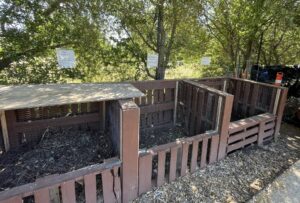By Debbie Arrington
Guest Writer
Healthy soil grows healthy plants. When roots have the right environment, they can produce more blooms, bigger tomatoes—and even save water and money.
So, how do you turn brick-like clay into a plant-friendly paradise? Start with banana peels, coffee grounds, dried leaves, and other green waste. The result is garden gold.
With the right mix of organic material, healthy soil retains moisture while creating a happy home for microorganisms, which convert those decaying scraps into nutrients roots can absorb. Adding compost to soil and topping with mulch mimics nature’s way of recycling—feeding the underground ecosystem and helping your garden thrive.
Placer County Master Gardeners Mariellyn Schoenhoff and Richard Huntley shared this approach at a recent mulch and compost workshop hosted by the San Juan Water District in Granite Bay. They walked attendees through how to turn everyday kitchen and yard waste
into rich compost and mulch.
“Before I became a master gardener, I had no idea what was going on in the soil,” says Schoenhoff, who lives and gardens in Auburn. “I didn’t really think about it.”
Now, she sees the benefits of compost and mulch daily. “Both help soil health a lot,” she says. “Adding compost helps open air pockets, which lets roots access more air and water. The soil is not so compacted. As the compost and mulch break down, they support microorganisms. It holds moisture so you use less water.”
Composting at Home
Schoenhoff uses a three-bin composting method at home:
- Fresh scraps go in the first bin.
- As they start to break down, they’re moved to a second bin to continue decomposing.
- Finally, they’re transferred to a third bin, where the finished compost is ready for the garden.
Composting is like cooking; it requires a mixture of certain ingredients, occasional stirring, and monitoring for success.
The Right Mix
Start with a balance of “greens” and “browns.” Greens are fresh and moist—like veggie scraps, grass clippings, coffee grounds, and banana peels. Browns are dry—such as fall leaves, shredded paper, and woody yard trimmings.
To speed the process, Schoenhoff suggests cutting all those ingredients into small pieces, less than an inch square. She uses no wood bigger than a pencil width.
What to leave out? Never use dairy products or oils, meat, chicken, fish, or bones, which can attract pests and need higher heat to break down safely.
Stir and Monitor
“Compost needs water and air,” she adds. Keep the compost pile moist like a wrung-out sponge. (She adds water with a hose as needed.) Then turn it with a pitchfork to aerate regularly (every few days).
This process usually takes about three to four months. A “hot method” can cut that time in half by reaching temperatures up to 140-150°F; any temp over that can kill worms, helpful micro/macro organisms and possibly be combustible.
Mulch: Your Garden’s Summer Shield
When finished, the compost can be mixed into the soil or spread around plants as a nutrient-rich mulch.
Mulch is like a blanket that maintains soil moisture while also keeping plant roots comfortable during summer heat. It’s vital around trees and shrubs.
“You don’t have to water as much,” Schoenhoff says. “It also suppresses weeds – which cuts down on work – and maintains soil temperatures, helps prevent erosion and improves soil structure.”
Schoenhoff’s favorite mulch: wood chips. “Native wood chips such as incense cedars, pines, and oaks – including trees chipped into mulch – support the soil underneath and its food web,” she says. “I asked a company trimming trees in my neighborhood for their chips, and they gave me a great big pile.”
For mulch to be most effective, Schoenhoff suggests layering it with compost underneath. “Water the soil, apply an inch layer of compost, top with two inches of mulch, then water again. That way, it will retain soil moisture a lot longer and you’ll be ready for summer.”
———————————————————————————————————————————-
Debbie Arrington is a longtime home and garden reporter and co-author of the blog Sacramento Digs Gardening: https://sacdigsgardening.californialocal.com/


